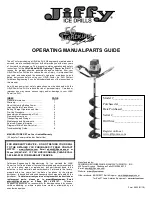
Operating Instructions
TAI4
TECHNOLOGIES GMBH
Release version/date: R1.1 / October 2019
© 2001-2019 TAPKO Technologies GmbH
Im Gewerbepark A15, 93059 Regensburg, Germany
Details, modifications and corrections may be subject to change without notice. TAPKO gives no warranty for the accuracy of the document. All rights reserved.
Product description
Connectors, buttons and LEDs description
The TAI4 Contact Interface is a 4-fold KNX binary input to sensor
contacts and to control/switch/operate KNX devices via classical
conventional switches and push buttons. The input module is suitable to
process binary signals of potential-free contacts. Due to its small
housing (diagonal of 50 mm) TAI4 finds enough room in a flush-
mounted box (Ø 60 mm) behind the switch. The connecting cable pairs
of 28 cm can be extended up to 10 m when twisted.
Designed for potential-free contacts such as conventional switches,
contact sensors and push buttons, TAI4 provides a 3.3 V sensing voltage
for contact scanning. All usual input functions like switching, dimming,
shutters, blinds control, counter and scenes can be used in a common
way.
Requirements of Directives EMC, RoHS and LVD are met. Standards for
residential, commercial, and industrial environments are fulfilled. The
full text of the EU declaration of conformity is available at the following
internet address:
Input
Programming button
Programming LED
red:
Programming Mode
active
KNX TP connector
Technical specifications
Power input
Power supply:
Current consumption:
Housing
Dimensions (HxWxD):
Flush mounting:
KNX bus connection:
Input cables:
Weight:
Inputs
Potential-free contacts:
Sensing voltage:
Sensing current:
21…30 V DC SELV
< 10 mA
43 x 42 x 11 mm
Box of Ø 60 mm x 40 mm
KNX connector (red/black)
4 pairs of 28 cm length
0.22 mm
2
(Ø 0.56 mm)
22 g
4
3.3 V
0.3 mA (100 mA short-time)
Environmental conditions
Operating temperature:
Storage temperature:
Ambient humidity:
Electrical safety
Pollution degree (IEC60664):
Protection type (IEC60529):
Protection class (IEC61140):
Overvoltage category (IEC60664):
Approbation (ISO/IEC14543-3):
CE Marking
EU Directives:
Standards:
-
5…45 °C
-25...70 °C
5…93 % (non
-condensing)
2
IP20
III
III
KNX-certified
LVD
(2014/35/EU)
EMC (2014/30/EU)
RoHS (2011/65/EU)
EN50491-2, EN50491-5-1,
EN50491-5-2, EN50491-5-3
EN50581
Mounting, commissioning and safety notes
Installation and maintenance
•
After connection to the KNX bus system, the device works with its
default settings as intended
•
Warning
: Do not connect to 230 V. The device is supplied by the
KNX bus and does not require any additional external power supply
•
The device may only be installed and put into operation by a
qualified electrician or authorized person
•
For planning and construction of electric installations the appropriate
specifications, guidelines and regulations in force of the respective
country have to be complied
•
The device must not be mounted in a box together with 230 V devices
and/or 230 V cables
•
Combinations of a push button device connected to both the TAI4
and a 230 V device (or sockets) at the same time are not allowed
•
Ensure that there is a safety separation (SELV) between connected
signal cables (including extensions) and other current and voltage
carrying devices and cables
•
When connecting the TAI4, ensure that it can be isolated
•
Prevailing safety and accident prevention rules must be heeded
•
Connect the KNX bus line as for common KNX bus connections with a
KNX bus cable, to be stripped and plugged into a KNX TP connector
•
Do not damage electrical insulations during connecting
•
For changing the configuration use the ETS
•
The housing must not be opened
•
Installation only in dry locations
•
Accessibility of the device for operation and visual inspection must be
provided
•
Protect the device from moisture, dirt and damage
•
The device needs no maintenance
•
If necessary, the device can be cleaned with a dry cloth
•
In the case of damage (at storage, transport) no repairs may be
carried out by unauthorized persons
•
Configuration details and ETS database:
A
B
C
D




















